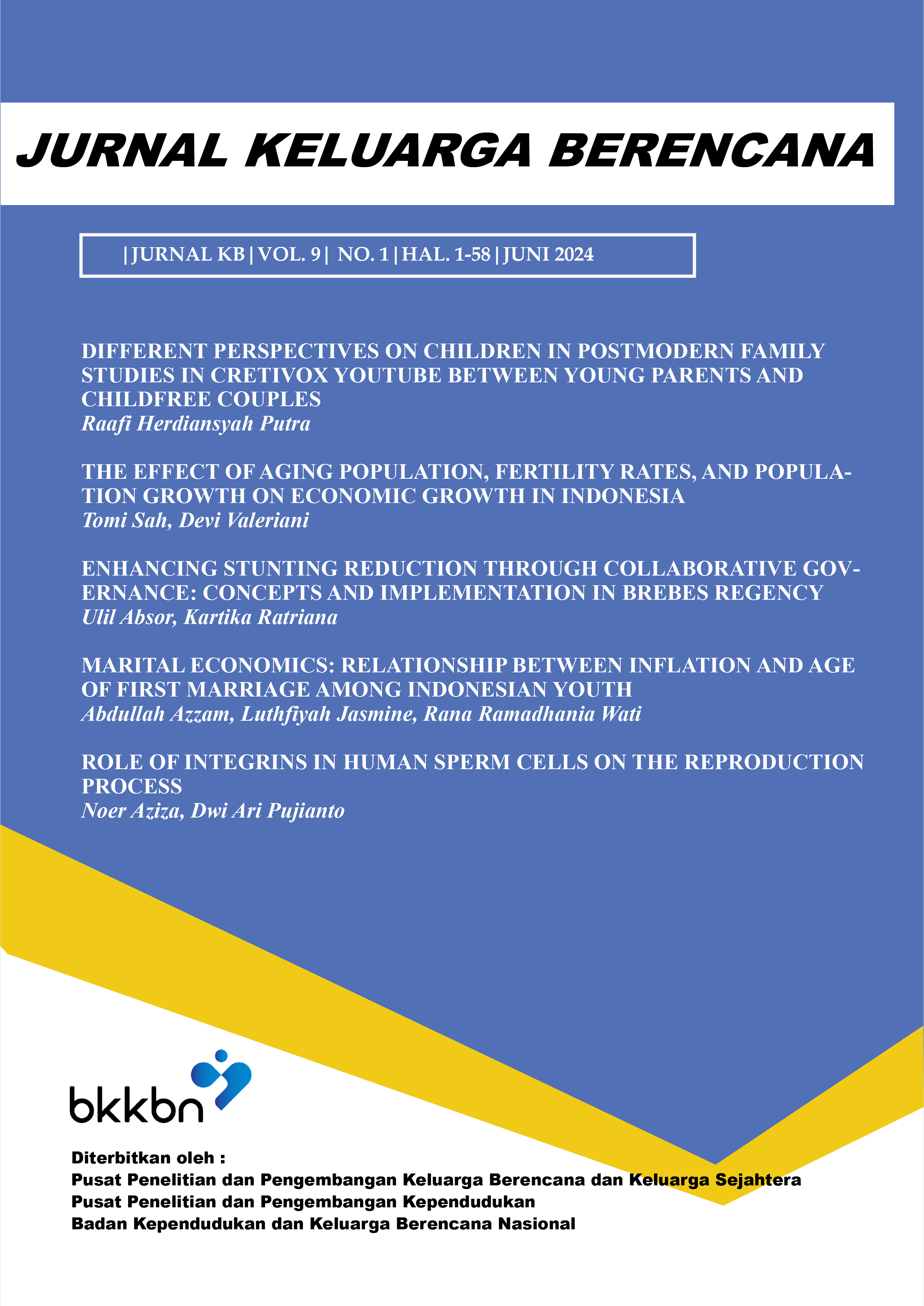THE EFFECT OF AGING POPULATION, FERTILITY RATES, AND POPULATION GROWTH ON ECONOMIC GROWTH IN INDONESIA
DOI:
https://doi.org/10.37306/xx8dpw51Keywords:
Population Growth, Aging Population, Fertility Rate, Economic GrowthAbstract
The declining fertility rate in Indonesia, coupled with an increasing aging population and continuous population growth, has become a national concern, leading to potential alterations in Indonesia’s economic landscape. This research delves into the ramifications of Indonesia's aging population, fertility rates, and population growth on its economic growth, employing a comprehensive analysis of time series data from 1961 to 2022. Utilizing multiple linear regression, this investigation aims to unveil the interconnectedness between demographic variables and economic advancement. This study found that the aging population has no statistically significant influence on economic growth. However, fertility rates demonstrate a notable negative impact on economic growth, while population growth showcases a significant positive influence on economic growth. These findings underscore the necessity for targeted policy interventions aimed at addressing demographic shifts to ensure sustainable economic development in Indonesia.
Downloads
References
Acemoglu, D., & Restrepo, P. (2017). Secular Stagnation? The Effect of Aging on Economic Growth in the Age of Automation. American Economic Review, 107(5), 174–179. https://doi.org/10.1257/aer.p20171101
Akinola, A. T. (2021). An Analysis on The Impact of Population Growth on The Economy of Nigeria. International Journal of New Economics and Social Sciences IJONESS, 14(2), 43–64. https://doi.org/https://doi.org/10.5281/zenodo.5971912.
Azam, M. (2022). Governance and Economic Growth: Evidence from 14 Latin America and Caribbean Countries. Journal of the Knowledge Economy, 13(2), 1470–1495. https://doi.org/10.1007/s13132-021-00781-2
Azam, M., Khan, H. N., & Khan, F. (2020). Testing Malthusian’s and Kremer’s Population Theories in Developing Economy. International Journal of Social Economics, 47(4), 523–538. https://doi.org/10.1108/IJSE-08-2019-0496
Bloom, D., Canning, D., & Sevilla, J. (2003). The Demographic Dividend: A New Perspective on the Economic Consequences of Population Change. RAND Corporation PP - Santa Monica, CA. https://doi.org/10.7249/MR1274
BPS. (2023). The 2023 Elderly Population Statistics of Indonesia. https://www.bps.go.id/id/publication/2023/12/29/5d308763ac29278dd5860fad/statistik-penduduk-lanjut-usia-2023.html
Bucci, A., Eraydın, L., & Müller, M. (2019). Dilution Effects, Population Growth and Economic Growth Under Human Capital Accumulation and Endogenous Technological Change. Journal of Macroeconomics, 62, 103050. https://doi.org/https://doi.org/10.1016/j.jmacro.2018.08.003
Chen, H.-J., Huang, S.-C., & Miyazaki, K. (2024). Life Expectancy, Fertility, and Retirement in an Endogenous-Growth Model with Human Capital Accumulation. Economic Modelling, 130, 106572. https://doi.org/https://doi.org/10.1016/j.econmod.2023.106572
Chen, J., Wang, Y., Wen, J., Fang, F., & Song, M. (2016). The Influences of Aging Population and Economic Growth on Chinese Rural Poverty. Journal of Rural Studies, 47, 665–676. https://doi.org/https://doi.org/10.1016/j.jrurstud.2015.11.002
Chen, S. (2024). Fertility Rate, Fertility Policy, and Climate Policy: A Case Study in China. Structural Change and Economic Dynamics, 69, 339–348. https://doi.org/https://doi.org/10.1016/j.strueco.2024.01.004
Cylus, J., & Al Tayara, L. (2021). Health, an Ageing Labour Force, and The Economy: Does Health Moderate The Relationship between Population Age-Structure and Economic Growth? Social Science & Medicine, 287, 114353. https://doi.org/https://doi.org/10.1016/j.socscimed.2021.114353
Degu, A. A. (2019). The Nexus Between Population and Economic Growth In Ethiopia: An Empirical Inquiry. International Journal of Business and Economic Sciences Applied Research, 12, 43-50. https://doi.org/https://doi.org/10.25103/ijbesar.123.05
Doepke, M., Hannusch, A., Kindermann, F., & Tertilt, M. (2023). Chapter 4 - The Economics Of Fertility: A New Era. In S. Lundberg & A. B. T.-H. of the E. of the F. Voena (Eds.), Handbook of the Economics of the Family, Volume 1 (Vol. 1, Issue 1, pp. 151–254). North-Holland. https://doi.org/https://doi.org/10.1016/bs.hefam.2023.01.003
Goh, S. K., McNown, R., & Wong, K. N. (2020). Macroeconomic Implications of Population Aging: Evidence from Japan. Journal of Asian Economics, 68, 101198. https://doi.org/https://doi.org/10.1016/j.asieco.2020.101198
Götmark, F., & Andersson, M. (2020). Human Fertility in Relation to Education, Economy, Religion, Contraception, and Family Planning Programs. BMC Public Health, 20(1), 265. https://doi.org/10.1186/s12889-020-8331-7
Han, J.-S., & Lee, J.-W. (2020). Demographic Change, Human Capital, and Economic Growth in Korea. Japan and the World Economy, 53, 100984. https://doi.org/https://doi.org/10.1016/j.japwor.2019.100984
Hopenhayn, H., Neira, J., & Singhania, R. (2022). From Population Growth to Firm Demographics: Implications for Concentration, Entrepreneurship and the Labor Share. Econometrica, 90(4), 1879–1914. https://doi.org/https://doi.org/10.3982/ECTA18012
Jones, C. I. (2022). The End of Economic Growth? Unintended Consequences of a Declining Population. American Economic Review, 112(11), 3489–3527. https://doi.org/10.1257/aer.20201605
Kremer, M. (1993). Population Growth and Technological Change: One Million B.C. to 1990*. The Quarterly Journal of Economics, 108(3), 681–716. https://doi.org/10.2307/2118405
Lee, H.-H., & Shin, K. (2019). Nonlinear Effects of Population Aging on Economic Growth. Japan and the World Economy, 51, 100963. https://doi.org/https://doi.org/10.1016/j.japwor.2019.100963
Lee, J. H., Lim, E.-S., & Hwang, J. (2012). Panel SVAR Model of Women’s Employment, Fertility, and Economic Growth: A Comparative Study of East Asian and EU Countries. The Social Science Journal, 49(3), 386–389. https://doi.org/https://doi.org/10.1016/j.soscij.2012.01.006
Marois, G., Bélanger, A., & Lutz, W. (2020). Population Aging, Migration, and Productivity in Europe. Proceedings of the National Academy of Sciences, 117(14), 7690–7695. https://doi.org/10.1073/pnas.1918988117
Mason, A. (1997). Population and The Asian Economic Miracle. Asia-Pacific Population & Policy, 43. https://scholarspace.manoa.hawaii.edu/server/api/core/bitstreams/59356ac7-395f-495d-b2e9-f72a9cf67012/content
Miles, D. (2023). Macroeconomic Impacts of Changes in Life Expectancy and Fertility. The Journal of the Economics of Ageing, 24, 100425. https://doi.org/https://doi.org/10.1016/j.jeoa.2022.100425
Mohd, S. N. A., Ishak, A. A., & Selvaratnam, D. P. (2021). Ageing Population’s Impact on Economic Growth in Malaysia From 1981 to 2019: Evidence From an Autoregressive Distributed Lag Approach. Frontiers in Public Health, 9. https://www.frontiersin.org/journals/public-health/articles/10.3389/fpubh.2021.731554
Osiobe, E. (2019). The Effect of Australia’s Declining Fertility Rate 1978-2016. The International Journal of Human Resource Management, 9, 95–100. https://doi.org/10.5296/ijhrs.v9i4.15717
Pham, T. N., & Vo, D. H. (2021). Aging Population and Economic Growth in Developing Countries: A Quantile Regression Approach. Emerging Markets Finance and Trade, 57(1), 108–122. https://doi.org/10.1080/1540496X.2019.1698418
Salvati, L., Benassi, F., Miccoli, S., Rabiei-Dastjerdi, H., & Matthews, S. A. (2020). Spatial Variability of Total Fertility Rate and Crude Birth Rate in A Low-Fertility Country: Patterns and Trends in Regional and Local Scale Heterogeneity Across Italy, 2002–2018. Applied Geography, 124, 102321. https://doi.org/https://doi.org/10.1016/j.apgeog.2020.102321
Shen, C., & Zhao, X. (2023). How Does Income Inequality Affects Economic Growth at Different Income Levels? Economic Research-Ekonomska Istraživanja, 36(1), 864–884. https://doi.org/10.1080/1331677X.2022.2080742
Temsumrit, N. (2023). Can Aging Population Affect Economic Growth through The Channel of Government Spending? Heliyon, 9(9), e19521. https://doi.org/https://doi.org/10.1016/j.heliyon.2023.e19521
The World Bank. (2022). Population Age 65 and Above (% of Total Population). https://data.worldbank.org/indicator/SP.POP.65UP.TO.ZS. Accessed on February 24, 2024
The World Bank. (2023a). Fertility Rate, Total (Birth per Woman) - Indonesia. https://data.worldbank.org/indicator/SP.DYN.TFRT.IN?locations=ID. Accessed on February 24, 2024
The World Bank. (2023b). GDP Per Capita Growth (Annual %) - Indonesia. https://data.worldbank.org/indicator/NY.GDP.PCAP.KD.ZG?locations=ID. Accessed on February 24, 2024
The World Bank. (2023c). Population Ages 65 and Above (% of Total Population) - Indonesia. https://data.worldbank.org/indicator/SP.POP.65UP.TO.ZS?locations=ID. Accessed on February 24, 2024
The World Bank. (2023d). Population Growth (Annual %) - Indonesia. https://data.worldbank.org/indicator/SP.POP.GROW?locations=ID. Accessed on February 24, 2024
United Nations. (2019). World Population Ageing 2019. https://www.un.org/en/development/desa/population/publications/pdf/ageing/WorldPopulationAgeing2019-Report.pdf
Wong, A. (2019). Refinancing and The Transmission of Monetary Policy to Consumption. Unpublished Manussript. https://jfhoude.wiscweb.wisc.edu/wp-content/uploads/sites/769/2019/09/Arlene-Wong-refinancing.pdf
Ye, J., Chen, Z., & Peng, B. (2021). Is The Demographic Dividend Diminishing in China? Evidence from Population Aging and Economic Growth During 1990–2015. Review of Development Economics, 25(4), 2255–2274. https://doi.org/https://doi.org/10.1111/rode.12794
Yunker, J. A. (2024). Economic Growth in China and India: The Potential Role of Population. World Development Sustainability, 4, 100130. https://doi.org/https://doi.org/10.1016/j.wds.2024.100130
Downloads
Published
Issue
Section
License
Copyright (c) 2024 Tomi Sah, Dr. Devi Valeriani, S.E., M.Si.

This work is licensed under a Creative Commons Attribution-NonCommercial-NoDerivatives 4.0 International License.
Deprecated: json_decode(): Passing null to parameter #1 ($json) of type string is deprecated in /var/www/html/ejurnal/plugins/generic/citations/CitationsPlugin.php on line 68







